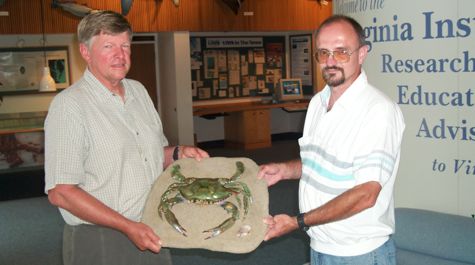Does giant blue crab set a new record?
When waterman Clarence "Juice" McKinney pulled his crab pot from the frigid waters of the Potomac River in November 1998, he got a big surprise--staring back at him was a male blue crab that stretched almost a foot between the tips of its lateral spines.
Jacques van Montfrans and Dr. Willard van Engel, crab experts at VIMS, say it's the largest blue crab they've ever seen or heard about, and may set a Chesapeake Bay and Virginia record. McKinney caught the crab on the Virginia side of the Potomac. It weighed 1.1 pounds and had a 10.72-inch-wide shell.

The big "jimmy" dwarfs most Chesapeake Bay blue crabs. The minimum legal width for a male blue crab is 5 inches. "The average width is around 5 1/2 inches," says van Montfrans. The first juvenile stage of the blue crab measures about 1/10 of an inch across the spines. Juveniles typically molt about 20 times before reaching maturity.
Despite its impressive width, the crab posed little threat to the McKinney's fingers. That's because it had tiny claws that had just started to re-grow after the crab somehow lost its original pair, "probably in a fight with another male blue crab when it was smaller," says van Montfrans. Crabs possess the useful ability to regenerate lost limbs.
In addition to its disproportionately small claws, the crab had also just molted, so its external skeleton was relatively soft. These two factors made mounting the crab a serious challenge for Eastern Shore taxidermist Arty Meredith, and help explain the lengthy hiatus between its capture and its upcoming appearance in VIMS' Watermen's Hall Visitors Center and Aquarium.
To restore the crab to its living splendor, Meredith had to fashion a new set of epoxy-resin claws by taking a mold from another (slightly smaller) male crab. He also airbrushed the claws and shell to their original iridescent shades of blue, red, and beige, and inserted thin wires internally to hold the fragile shell together.
Even with its smaller prosthetic limbs, the mounted crab still measures 22 inches between claw tips, slightly longer than the clawspan reported for the previous "record" blue crab, which was caught by long-time crabber Edwin Horton in the 1980s near where Pagan Creek enters the James River.
Horton, who started crabbing in 1951, said his 21-incher was " the biggest old crab" he ever saw. Unfortunately, it was irreparably damaged during mounting, so there can be no claw-to-claw comparison for bragging rights between the two monsters.
The colossal crab will go on display in the VIMS Visitors Center on August 15th. For information on visiting, visit the VIMS website at www.vims.edu or call 804-684-7846.